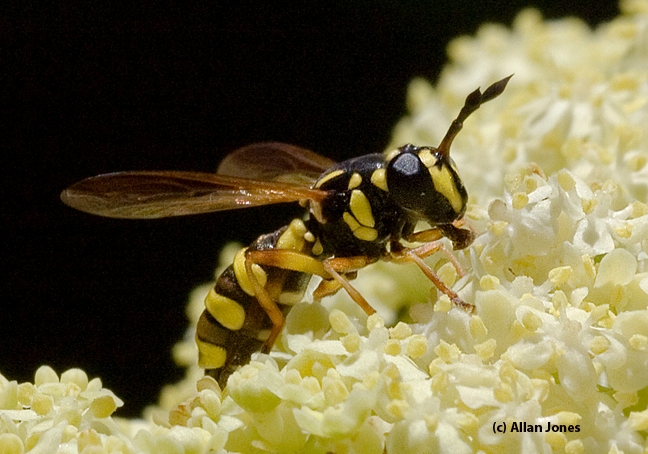- Author: Kathy Keatley Garvey
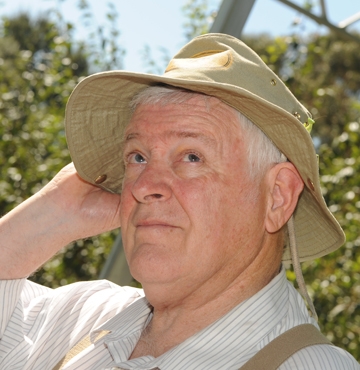
Arthur Shapiro, distinguished professor of evolution and ecology at UC Davis, annually sponsors the "Beer for a Butterfly" contest, offering a pitcher of beer for the first cabbage white butterfly (Pierae rapae) of the year found in the three-county area of Sacramento, Yolo and Sacramento. He launched the contest in 1972 as part of his long-term studies of butterfly life cycles and climate. This year he again won the contest; he collected a newly eclosed butterfly at 1:56 p.m. Thursday, Jan. 19 near the Solano Park Apartments on the UC Davis campus.
But where's the first bumble bee of the year in the Yolo county area?
Drum roll...
At 2:02 today (Friday, Jan. 27) naturalist and insect photographer Allan Jones of Davis alerted us: "Two Bombus melanopygus on manzanita just east of the redwood grove (UC Davis Arboretum)."
And then he found another melanopygus. It was a three-in-one day.
The story behind the story: five years ago, a small group of keen-eyed bumble bee aficionados (Robbin Thorp, distinguished emeritus professor of entomology at UC Davis and co-author of Bumble Bees of North America: An Identification Guide; and three naturalists and insect photographers Gary Zamzow and Allan Jones of Davis, and yours truly of UC Davis) launched our own contest.

In an unusual twist, Jones found both genders at the same time. After finding and photographing two males just east of the Arboretum's redwood grove, he spotted and photographed a female just west of it.
"Surprising to see males this early in the season," noted Thorp, who co-authored the book, California Bees and Blooms: A Guide for Gardeners and Naturalists. "Unusual to see males before any workers are on site. Could be from a gyne that overwintered but was not mated before she went into hibernation; or maybe the sperm she received were not viable; or maybe she was unable to release sperm from her spermatheca to some eggs as they passed through her reproductive tract."
"At any rate," Thorp told Jones, in congratulating him, "you got two firsts for the season at one time."
Great job, Allan Jones! And the bumble bee season begins...
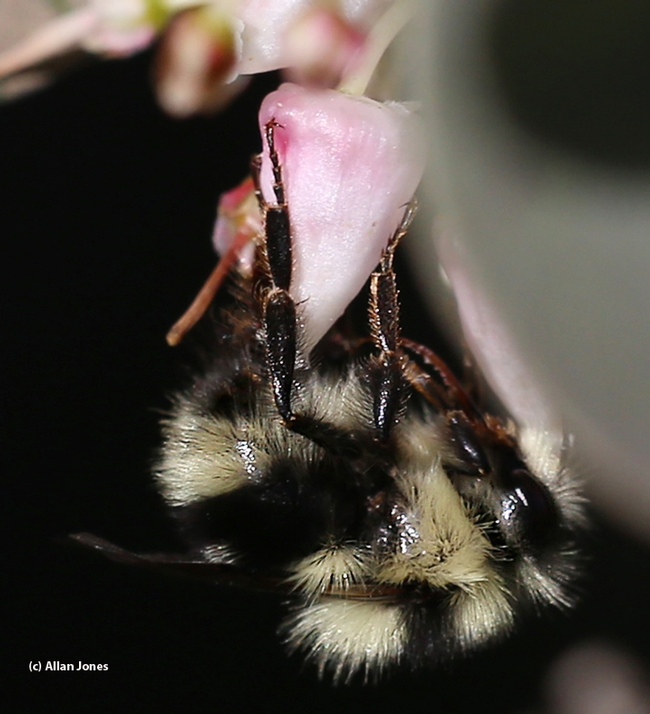
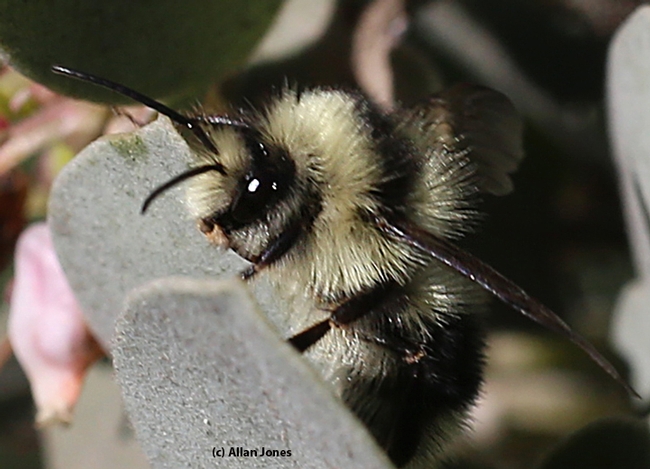
- Author: Kathy Keatley Garvey
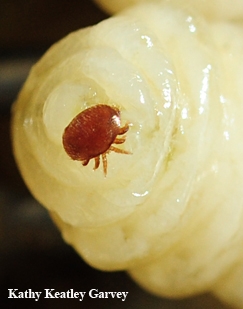
We remember seeing a varroa mite attached to a foraging honey bee one warm summer day in our pollinator garden. The mite was feeding off the bee and the bee was feeding on the nectar of a lavender blossom.
Didn't seem fair.
We've never seen a varroa mite on bumble bees or carpenter bees, but Davis photographer Allan Jones has--and he's photographed them. (See below)
When varroa mites tumble off a honey bee and into a blossom, they can hitch a ride on other insects, such as bumble bees and carpenter bees.
"Varroa have been recorded hitching rides on bumble bees and yellowjackets," observed native pollinator specialist Robbin Thorp, distinguished emeritus professor of entomology at UC Davis. "Varroa have been reported as feeding on larvae of these and other critters--but not successfully reproducing on them. Also bumble bees and yellowjackets typically overwinter as hibernating queens not as perennial colonies like honey bees. Thus they are not suitable hosts for Varroa."
Extension apiculturist emeritus Eric Mussen says that bees other than honey bees aren't reproductive hosts for the varroa mite.
"As far as I know, Varroa destructor may be able to find soft areas of the exoskeleton of insects other than honey bees and feed on them," he says. "I have no idea whether or not the substitute hemolymph would sustain the mites for very long. The mites have practically no digestive capabilities. They simply utilize the previously-synthesized bee blood, to which they seem to be perfectly adapted."
"Since the mites reproduce on honey bee pupae, there are a number of considerations about potential other reproductive hosts," Mussen said, citing:
- Are the nutrients of the substitute host close enough to those of honey bees to support immature mite development?
- Can immature mites that develop properly at honey bee cell environmental conditions (temperature and relative humidity) find a similar environment in the nests of other insects?
- Do other insects tolerate the presence of mites on their bodies or in their brood nests?
Like honey bees, bumble bees do segregate their pupae in single cells, Mussen says, but he was unable to find any studies devoted to whether bumble bee pupal conditions support Varroa destructor reproduction.
Sounds like a good research project!

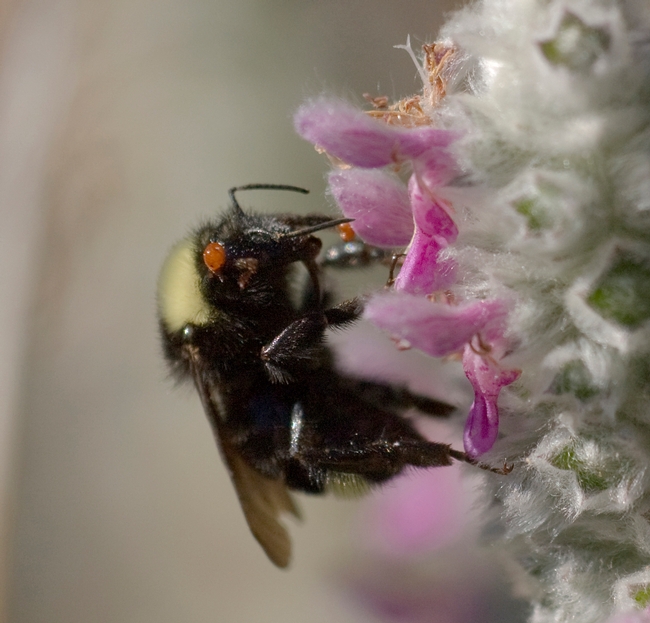
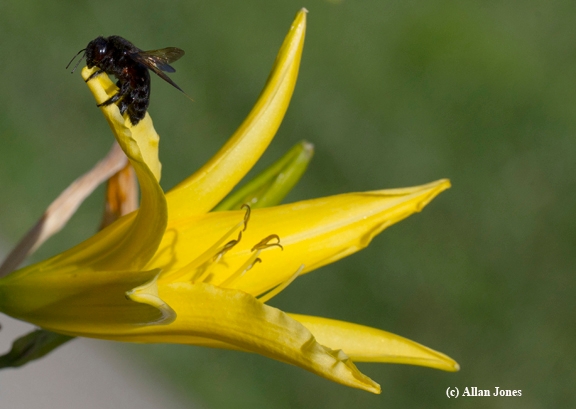
- Author: Kathy Keatley Garvey
"Got 'em!"
That's the message we've all been waiting for.
Several of us bumble bee enthusiasts--Robbin Thorp, distinguished emeritus professor of entomology at UC Davis, photographers Allan Jones and Gary Zamzow of Davis, and yours truly--have been searching for the first bumble bee of the year since...well...Jan. 1.
We've been hanging out near manzanita bushes, knowing that this is usually the place to find newly emerged bumble bees this time of year.
So today, Jones won. He headed over to "two beautiful manzanitas" near the off-ramps at Russell and Route 113, Davis, and spotted both the yellow-faced bumble bee, Bombus vosnesenskii, and the three-banded bumble bee, Bombus melanopygus. He captured these images (below) at noon.
"I believe they are also at Hutchinson and 113, but I did not need to go that far," Jones mentioned. "The bees seemed very wary and were high overhead so I was only able to get record shots."
Good job, Allan! You nailed it!
And just in time for Valentine's Day.
Note: If you want to learn more about bumble bees, check out Bumble Bees of North America: An Identification Guide (Princeton University Press) and California Bees and Blooms: A Guide for Gardeners and Naturalists (Heyday) both co-authored by Robbin Thorp and other scientists.



- Author: Kathy Keatley Garvey
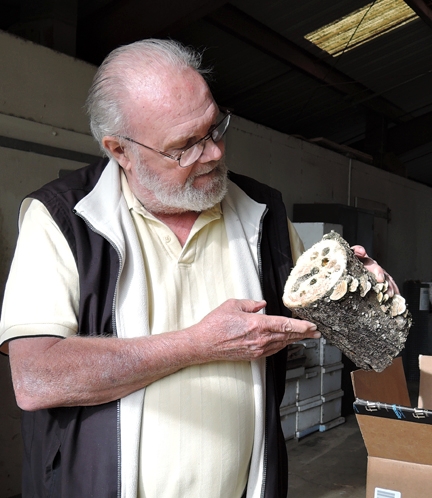
Gold?
When a rotten apple tree was cut down last week on private property in Davis, scores of eyes peered from the drilled holes. Soon, adult male Valley carpenter bees (Xylocopa varipuncta)--those green-eyed golden bees known as "teddy bears"--emerged with their female counterparts. The males and females look nothing alike; the females are solid black.
As entomologists know, the females drill holes in wood to lay their eggs. When the adult females and males emerge from their cells, they "wait it out" until spring or when the weather warms enough for them to take flight. It gets pretty cold in Davis.

Talented insect photographer Allan Jones of Davis got the carpenter-bee call. "My good friend's son, a football player up from Claremont, cut down the rotten apple tree," Jones said. Surprise! Insects began crawling from the drilled holes.
Jones knew immediately what they were. He's photographed hundreds of them. He picked up the golden bees, knowing that "boy bees can't sting" and delivered them to native pollinator specialist Robbin Thorp, emeritus professor of entomology at UC Davis.
"The golden boys were all clinging together in a little ball when I left (the Laidlaw facility)," Jones said.

Thorp plans to keep them chilled to see if they survive the winter. They also will be part of "show and tell" at the Bohart Museum of Entomology's open house from 1 to 4 p.m., Sunday, Jan. 11 in Room 1124 of the Academic Surge Building on Crocker Lane.
The male Valley carpenter bees are often mistaken for a new species of bumble bee. In fact, some refer to them as "golden bumble bees."
The Valley carpenter bees are the largest carpenter bee in California. They are included in the newly published California Bees and Blooms: A Guide for Gardeners and Naturalists, co-authored by entomologist Gordon Frankie of UC Berkeley, Thorp, entomologist-photographer Rollin Coville and UC Berkeley botanist and curator Barbara Ertter.
Xylocopa varipuncta inhabits the Central Valley, Santa Clara Valley, and Southern California. At many garden events, visitors are surprised when Thorp picks up a male Valley carpenter bee and lets them hold it and feel the vibrating buzz.
"Boy bees can't sting," he tells them. "They're bluffing."

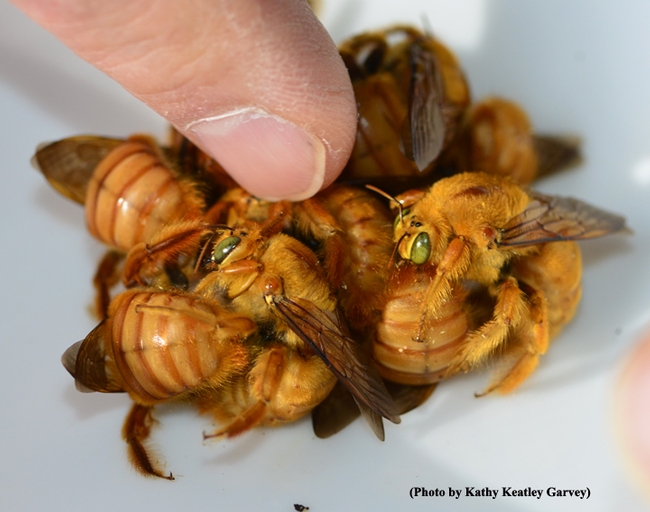

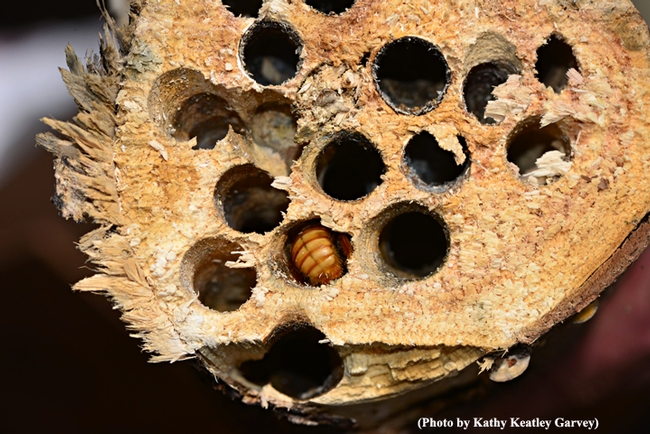
- Author: Kathy Keatley Garvey
Last weekend a little critter made its first-ever appearance in our family bee garden. It was neither a grand entrance nor a grand insect.
"A fly!" I thought, as I looked at its knoblike bristle or arista on the end of each antenna.
But its body--what little I could see of it before it winged out of there--definitely resembled a wasp. A Western yellowjacket (Vespula pensylvanica) or European paper wasp (Polistes dominula).
Native pollinator specialist Robbin Thorp, emeritus professor of entomology at the UC Davis Department of Entomology and Nematology, identified it as a syrphid fly, genus Ceriana, family Syrphidae.
Talented Davis photographer Allan Jones captured an excellent photo of Ceriana in 2012. A full body shot: head, thorax and abdomen! His excellent image (second one, below) shows the distinguishing characteristics: two wings (fly), not four wings (bees, wasps), as well as the arista (fly) and the spongelike mouthparts (fly).
BugGuide.Net posted some excellent images of Ceriana on its site. Class: Insecta. Order, Diptera. Family: Syrphidae: Genus: Ceriana.
Ceriana is a genus of wasp mimics. Basically, it's a syrphid fly, a pollinator. It's also known as a hover fly or flower fly as it hovers, helicopterlike, over flowers before drops down to forage.
Would-be predators, no doubt, avoid Ceriana because of its coloration. "Oops, don't mess with that! That's a wasp!"
Picnickers who don't know a faux wasp from a real one would probably run from it, or swat at it.
"It's definitely a good mimic and probably gets a lot of protection from that coloration," said Lynn Kimsey, director of the Bohart Museum of Entomology and professor of entomology at UC Davis.
So true!

